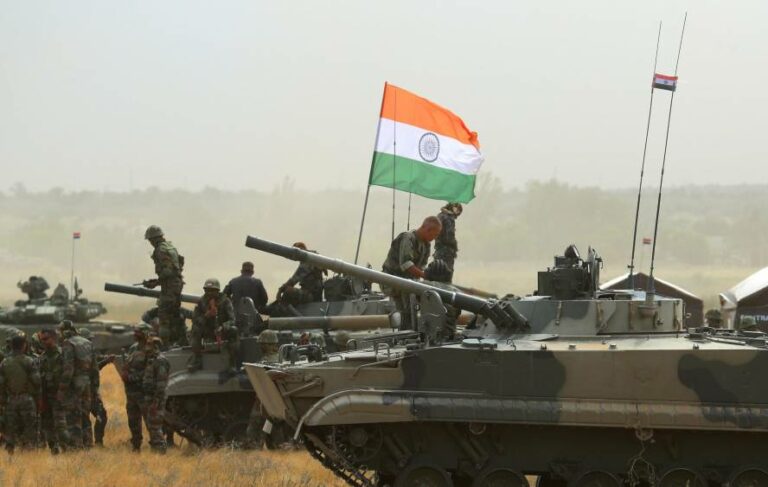Indian Equity market is witnessing a downward trend since the last October. Nifty 50 after reaching its all-time high of 18604 in October 2021 has fallen by 16 per cent. This fall in the market is due to a combination of global and local factors, which does not seem to subside in near future. One of the factors that have pushed the global economy into slippery path is invasion of Ukraine by Russia. This has put huge pressure on already worsening global supply chain.
In all these turmoil in the market, defence stocks have fallen less and have shown resilience. You might be wondering, what might be the reason behind such stubbornness in the defence stocks. One of the factors that have made a tectonic shift in the mind of many nations is Russia’s invasion of Ukraine, which has forced them to hike their defence budget.
For example Germany allocated USD 113 billion towards their military spending and even our hostile neighbor China has increased its defence spending by 7.1% and revised its target to USD 229 billion. Many other countries have also increased their defence budget and hence defence stocks have outperformed in the process. So, countries in the world are making defence their priority and an arms race once again after the end of Cold War.
This situation presents Indian defence manufacturing companies two major opportunities. First is manufacturing for India and second is manufacturing for the world market.
Indian Market
India is among the top five countries with the highest military spending. While the large armies with high technological base are self-dependent, having a robust military industrial complex, Indian defence industries in yet to mature even after 75 years of independence. India has the second-largest standing army in the world and has the infamous distinction of being the largest arms importer.
For a country as large as India, with vast land frontiers and hostile neighbours, its defence cannot be guaranteed on importing its military weapons, ammunitions and equipments to the tune of 75 percent, including critical technologies. Only answer to its strategic needs is self-reliance. Hence, in last few years right moves are being made to increase the indigenization of defence imports. Capital expenditure outlay for the defence sector has increased significantly by 13% in the Budgetary Allocation of FY 23. A total of 68 % of the capital procurement budget will be earmarked for domestic industries for 2022-23. This is a marked jump of 10% from the previous year’s 58% allocation. So, only 32% of projects will be outsourced. This will help Indian defence companies get more projects and generate higher revenues. All of this will take defence stocks to new heights.
Export Market
Increased military spending in both Russia and China have seen a number of countries up their defense spending globally. India can exploit this opportunity. There has also been a considerable increase in exports of equipment across the globe from India. In the year 2014-2015, India had exported defence equipment worth Rs. 1,940.64 crores. Whereas in 2020-2021, the total exports of defence equipment amounted to a whopping Rs. 8,434.84 crores. This is likely to see exponential growth going ahead.
India after having clinched a Rs 2,770 crore deal in January-end to export at least three ‘Brahmos’ missile batteries for the Philippines Navy, it is looking eagerly ahead to do more ‘Brahmos’ business with Vietnam. In the last few years, India has exported personal protective items or bulletproof gear and armour plating for military vehicles to the Philippines. Now India is exploring the defence deals with Indonesia and Vietnam to sell its Indo-Russian missile, Brahmos.
India has been in talks with the ASEAN nations for a long time over the export of Brahmos missiles and experts are predicting that it should be able to make inroads into the South-East Asian nations as pressure from China mounts.
The United States (39%) and Russia (19%) contributed over half of major weapons exports between 2017 and 2021. Following the former Cold War superpowers, France, Germany, and China were the leading global suppliers. Looking at the current government focus, India can also make inroad to this export market. Self-reliance and indigenization in defence is important for both strategic and economic reasons and has, therefore, been an important guiding principle for the government. Though India has made rapid strides in defence technology and industrial base in recent past, it is yet to cover a significant ground in terms of new products development and scale of production.
The domestic defence industry would have limited scope for investment in R&D and production if it relies only on the domestic demand. Hence coupled with domestic demand and catering to export market, defence sector can be a sunshine sector.
A total of 68 % of the capital procurement budget will be earmarked for domestic industries for 2022-23. This is a marked jump of 10% from the previous year’s 58% allocation. So, only 32% of projects will be outsourced. This will help Indian defence companies get more projects and generate higher revenues. All of this will take defence stocks to new heights
Still retaining tag of top importer, India is an emerging weapons exporter
‘Make in India’ in defence equipment manufacturing is no more an elusive mirage. India is emerging as a supplier for international arms manufacturers but despite locally making warships, fighter jet Tejas, nuclear submarine INS Arihant, missiles like Akash and BrahMos, India is still among the top-two global importers of weapons.
India is now making weapons, arms, ammunition, warships and planes for the international market and also for its own use. However, it cannot altogether avoid importing equipment. It will take time for the Indian industry to design, develop and manufacture major equipment, weapon systems and platforms.
Sweden-based think tank Stockholm International Peace Research Institute (SIPRI), in its report has compared two five-year blocks between 2012-16 and 2017-21 saying Indian arms imports decreased by 21 per cent. However, still India remains the world’s largest importer of major arms in 2017-21 and accounted for 11 per cent of total global arms imports in the period. In the same report, India is mentioned at the 23rd spot among top 25 exporters of weapons, with Myanmar, Sri Lanka and Armenia being its top customers. And this does not include the $374.96 million export order for Brahmos missile to the Philippines inked in January this year.
In a written reply in the Lok Sabha, junior Defence Minister Ajay Bhatt said that the value of arms exports by India has grown approximately by six times since 2014, with the ongoing financial year registering Rs 11,607 crore till now from Rs 1,941 crore in FY15. During this period, many reforms/steps have been taken up by the government to boost defence exports and enhance ease of doing business. The expenditure on defence procurement from foreign sources has gone down from 46 per cent to 36 per cent, thereby reducing the import burden in the last three years, from 2018-19 to 2020-21.
Government’s Target
The Indian government has set an ambitious annual export target of around Rs 36,500 crore by 2025 and the corporatisation of the Ordnance Factory Board and its 41 factories into seven defence PSUs will also help in boosting exports.
In August 2020, the Government announced a target of touching $5 billion in exports annually by 2025 and domestic defence production at $25 billion annually. In the last fiscal, military equipment exports saw a huge jump from five years ago, for the fiscal ending March 31, 2017, when exports were Rs1,522 crore. For the fiscal ending March 2021, the total domestic production, private and public, stood at Rs 84,667 crore (approximately $11.2 billion) and well on its way for the $25 billion target. The numbers could be greater for the fiscal ending March 2022.
Export of Military Equipment
| Year | Value in Rs Crore |
| 2014-15 | 1941 |
| 2015-16 | 2059 |
| 2016-17 | 1522 |
| 2017-18 | 4682 |
| 2018-19 | 10746 |
| 2019-20 | 9116 |
| 2020-21 | 8435 |
| 2021-22 | 11607 |
Indian Private Defence Industry
The Defence Acquisition Council has cancelled nine proposals of import worth Rs 46,695 crore.
Innovations for Defence Excellence (iDEX) is engaging industries, including MSMEs, startups, individual innovators, R&D institutes and academia, with a budget of Rs498.78 crore for financial support. The ‘positive indigenisation list’ now has 2,851 items, which cannot be imported after a pre-decided cut-off date.
The capital budget meant for acquisition of equipment for the present fiscal is Rs1,52,370 crore, which is a 76 per cent jump over Rs86,741 crore allotted in 2013-14. About 68 per cent of capital spend is expected to be on domestic sources. Research and development now has a budget of Rs11,981 crore; start-ups, academia and private industry are to be allowed to claim 25 per cent of it. In the past three years, the MoD has accorded Acceptance of Necessity (AoN) the first step to procure for equipment worth Rs2,47,515 crore from domestic makers. Out of the total 191 acquisition contracts signed in three years, 121 were with Indian vendors.
Indian private companies now make entire systems, parts and components for global manufacturers while also being suppliers to Indian armed forces. These companies are in joint ventures with foreign manufacturers and have joined their global supply chains.
Some of the notable achievements are –
- Larsen and Toubro is making guns, warships and hulls of nuclear submarines.
- Kanpur-based Lohia Group is into 100 per cent exports.
- Bharat Forge and Tata are making artillery guns for the Army.
- Adani makes complete carbon composite aerostructures for Hermes 900 UAV for an Israeli company.
- Mahindra is making the ULH M77 guns in collaboration with BAE systems. Also has a contract with Indian Navy to make submarine warfare suites.
- Dynamatic Technologies is making aero structures for global companies like Bell, Airbus and Boeing.
- Idea Forge signed a contract with the Indian Army for smaller tactical UAVs.
- Bengaluru-based New Space and Technologies has inked a contract with the MoD to make a high-altitude communications and surveillance ‘pseudo satellite’ that can remain airborne for months.
- Some companies are in various stages of development in the field of Artificial Intelligence, unmanned fighter jets, armed UAVs and robotics.
Tata in Big Lead
- The world’s biggest military equipment company, Lockheed Martin, in December last year formally recognized Tata-Lockheed Martin Aerostructures Limited (TLMAL) as a potential future co-producer of fighter wings. The TLMAL facility is integrated into Lockheed Martin’s global supply chain for making parts of the C-130J planes.
- Airbus has tied up with Tata to make the C295 military planes in India.
- Boeing has a joint venture with Tata for making aerostructures of helicopters.
Considering such bright future, on the following pages, we are providing a list of seven defence stocks that investors can consider to make a robust portfolio with a long term investment horizon.
If you are reading this on a mobile app, please click here
Defense Stocks
Bharat Dynamics Limited
Bharat Dynamics Limited (BDL), a Government of India Enterprise under the Ministry of Defence was established in Hyderabad in the year 1970 to be a manufacturing base for guided missiles and allied defence equipment. Nurtured by a pool of talented engineers drawn from DRDO and aerospace industries, it began its journey by producing the first Generation Anti -Tank Guided Missile (ATGM) – the French SS11B1. This product was a culmination of a Licence Agreement the Government of India entered into with Aerospatiale, French Republic. On successful completion of the SS11B1 project, the company embarked on production of second generation ATGMs – the French MILAN – 2 and Russian Konkurs. Bharat Dynamics has three manufacturing units, located at Kanchanbagh, Hyderabad, Telangana; Bhanur, Medak district, Telangana and Visakhapatnam, Andhra Pradesh. Two new units are planned at Ibrahimpatnam, Ranga Reddy district, Telangana and Amravati, Maharashtra.
In March 2018, Bharat Dynamics got listed below the offer price of Rs 428. But its fortunes have changed in the last few months. It touched an all-time high of Rs 904.95 before dropping to the current level. Since the start of the year, its returns were at 70% at June end closing.
The company has recently signed a contract worth Rs 2,971 crore with the Ministry of Defence to supply ASTRA MK-I Beyond Visual Range (BVR) Air to Air Missile and associates types of equipment to the Indian Air Force and Indian Navy. Company will be prime beneficiary of the indigenisation of the defense spending and is likely to keep its momentum going.
Bharat Electronics Limited
Bharat Electronics Limited (BEL) is an Indian Government-owned Navratna company that manufactures and supplies electronic equipment and systems to the defense sector as well as for non-defense markets. Its defense products, which contributed 88 per cent of total revenue, include Defense Communication Products, Land-based Radars, Naval Systems, Electronic Warfare Systems, Avionics, Electro Optics, Tank and Armored Fighting Vehicle Electronic Systems, among others. Its non-defense products which contribute 12 per cent to revenues include Cyber Security, e-Governance Systems, Homeland Security, Civilian Radars, and Telecom and Broadcast Systems, among others. The company plans to increase the total share of non-defence business in total sales to 20% in the next two to three years from 12% at present. The company plans to focus on manufacturing for the civil aviation and healthcare solutions sectors, and for railway/metro stations.
BEL has bagged orders to the tune of Rs 19,200 crore in FY22 while total order backlog was at Rs 57,570 crore as of March 2022 end. The company has also signed a contract with Airbus for supply of radar warning receiver (RWR) and missile approach warning systems (MAWS) as part of offset under C295 aircraft programme of GoI.
For FY22 revenues were at Rs 15,313.7 crore, up 8.9% YoY. EBITDA increased 4% YoY to Rs 3,309.2 crore as better revenue growth was partially negated by contraction in EBITDA margin. PAT for FY22 increased 13.7% YoY to Rs 2,348.9 crore. Overall, it is expected that company will post double digit revenue and order inflow growth along with sustained margins and strong order book.
Hindustan Aeronautics Limited
Hindustan Aeronautics Limited is an India-based aerospace and defense company. The Company designs and develops a range of aircrafts that include fighter, trainer and transport aircrafts, military and civil helicopters. It also develops aircraft engines, avionics and accessories, such as special test equipment, ground handling equipment, and ground support equipment. The Company manufactures its aircraft using both indigenous and licensed Russian and Western origin technologies. Its range of aircrafts includes Su-30 MKI aircraft, Light Combat Aircraft (LCA) Tejas, Dornier Do-228 Aircraft, Advanced Light Helicopter (ALH) Dhruv, Light Combat Helicopter (LCH) etc.
At the end of Q4FY22, company has order of around Rs 25000 crore, which mainly includes repair and overhaul and 15 LCH which is expected to be executed in this year. Further, the company expects order of approximately 240 aircraft engines for Su 30 and 80 RD 33 engines for MIG 29 with a combined value anywhere between Rs320-33000 crore this financial year.
HAL has got a fixed price quotation (contract nature), where the base year verification is done and for the subsequent pricing period which could be as long as seven years. Based on the financial parameters finalised, company keeps getting the prices, revenue generated. Once HAL gets the base year prices verified, all achieved operational efficiencies in cost of material, labour costs (learning curve / improved productivity), accrues to HAL and is retained by the company till the next pricing period is through. This is one major reason why operating profit remains at around 17%. Higher order book is one of the strongest points.
Garden Reach Shipbuilders & Engineers Limited 283
GRSE, one of India’s leading shipyards, is engaged in the construction of war ships. The company offers frigates, anti-submarine warfare corvettes, missile corvettes, landing ship tanks, landing craft utilities, among others to the Indian Navy, Indian Coast Guard, and other governments. It also provides portable bridges, deck machinery items, marine pumps, anchor capstan and anchor windlass. In addition, the company engages in the testing and overhauling of marine propulsion engines, as well as assembly of semi-knocked down units of diesel engines.
GRSE recorded its highest-ever turnover of Rs 1,750 crore during financial year 2021-22, reflecting a year-on-year (YoY) growth of 53 per cent. Company has also declared an interim dividend of Rs 4.95 per equity share for FY22 against Rs 3.85 in FY21, an increase of 28.57 per cent. The shipyard is currently undertaking concurrent construction of 23 ships, including three P17A stealth frigates, four survey vessels and six patrol boats, for Indian Navy, India Coast Guard, Republic of Guyana and Bangladesh. GRSE, which delivered one fast patrol vessel PS Zoroaster to the Government of Seychelles last year, said it is working on bringing new products for the commercial sector such as hovercrafts and electric ferries.
GRSE has good revenue visibility with close to Rs 24072 crore orders; it is 14 times its annual revenue currently. Moreover, it continues to deliver strong growth in revenue and earnings on the back of these orders. Besides strong orders, the company’s robust balance sheet, cash in the books, superior return ratios and margins, and capabilities to execute makes it a prefer bet among defence stocks.
Mazagon Dock Limited
Mazagon Dock is a premier shipyard constructing warships as well as offshore platforms. Main activities are ship building, ship repairs and fabrication of offshore structures with facilities situated at Mumbai and Nhava. Company has the capability to build warships, submarines, merchant ships upto 30,000 DWT and fabrication of well head platforms, process and production platforms and jack up rigs. The company is also in the business activities of Submarine, Shipbuilding. The shipyard was nationalised in 1960 and is now a PSU of the Government of India. It has built 795 vessels including 25 warships ranging from advanced destroyers to missile boats and 3 submarines. The company generates 89% of its revenues from ship construction, 8% from the sale of base and depot spares and 3% from the ship repair segment.
Many will doubt the future growth of the company as it has only one big customer, the government. This has its own advantage at current juncture. Centre wants to promote indigenisation, which is a big market for the company. It will help company to make profits and keep investors hooked.
The current correction in stock markets is making many high-quality stocks look attractive including Mazagon Dock. Despite its strong fundamentals, earnings growth, and robust order book, the stock has fallen from a high of Rs 342 apiece in April this year to Rs 253 now. It is trading at 7 times its fiscal 2024 estimated earnings, and is now offering a dividend yield of close to 3 percent.
Strong financial performance, attractive valuation and good dividend yield makes this PSU a good bet.
Mishra Dhatu Nigam Limited
Mishra Dhatu Nigam (MIDHANI) was established under Ministry of Defence with a view to achieve self-reliance in production and supply of various super alloys, special steels, materials to Defence, other Strategic Sectors for Nuclear, aeronautical and Space applications. The guiding factors for setting up of MIDHANI were the demand for Defence oriented technologies, which come under the national priorities. It is poised to grow from a single unit organization to a multi-unit organization as existing sectors and businesses may not be sufficient for accelerated growth. The Company also provides testing, evaluation and consultancy services.
MIDHANI has recorded highest ever sales of Rs 861.73 crore (provisional and unaudited) for FY 2021-22 compared to Rs 813.23 crore for FY 2020-21. Highest ever Exports of Rs 87.02 crore was recorded for FY 2021-22 compared to Rs19.42 crore for FY 2020-21. Even with disruption in production activities due to the second wave of pandemic, MIDHANI was able to mitigate the impact on production with better planning and execution. During the year, MIDHANI continued its focus on cost optimisation measures including indigenisation of various components.
Company is investing heavily into its business and along with a high rate of return that has resulted in a respectable growth in its earnings. For last three years, its profit has grown at a CAGR of 11 per cent. If the company continues to grow its earnings the way it has, that could have a positive impact on its share price, which is down by 17 per cent from its recent high of Rs 215, given how earnings per share influence long-term share prices.
Rossell India Limited
Rossell India Limited was formerly Rossell Tea Limited. The company has diverse interests in Tea, Aviation and Hospitality. To better reflect the diversification of its businesses, and to create a unified brand, the company, on the 19th of April 2011, rechristened itself as Rossell India Limited. Post this rechristening Rossell India has also restructured itself into three divisions – Tea, Aviation & Defence (Technology and Engineering) and Product Support Services (Aerospace). In the Aerospace and Defence segment, the company has JV’s, partnerships and service agreements with leading OEMs of the world. Apart from this, Rossell India also has strategic partnerships in the Hospitality sector.
Rossell Techsys, is the Aerospace & Defense Division of Rossell India Limited, which operates from a state-of-the-art 225,000 sq. ft. LEED Gold rated facility at Bangalore, providing custom engineering and manufacturing services in Electrical Wiring & Interconnect Systems, Electronic System & Systems Integration, Test Equipment and After-Market Product Support Services. Company is an an integral part of Boeing’s global supply chain, and Rossell Techsys has been manufacturing and delivering critical components for Boeing’s key defence platforms with quality and precision. Company has recently completed 100,000 deliveries to Boeing for its various platforms, including 50,000 deliveries for the Apache platform alone.
The stock is trading at a PE multiple of 26.2. For the past five years, the profit growth has been at 55 per cent, which is impressive. All these factors have been noticed by institutional investors and for the quarter ending March 2022 both FIIs and DIIs have increased their stake in the company.





















